dashboard Alfa Romeo Giulietta 2013 Owner handbook (in English)
[x] Cancel search | Manufacturer: ALFA ROMEO, Model Year: 2013, Model line: Giulietta, Model: Alfa Romeo Giulietta 2013Pages: 292, PDF Size: 13.06 MB
Page 107 of 292
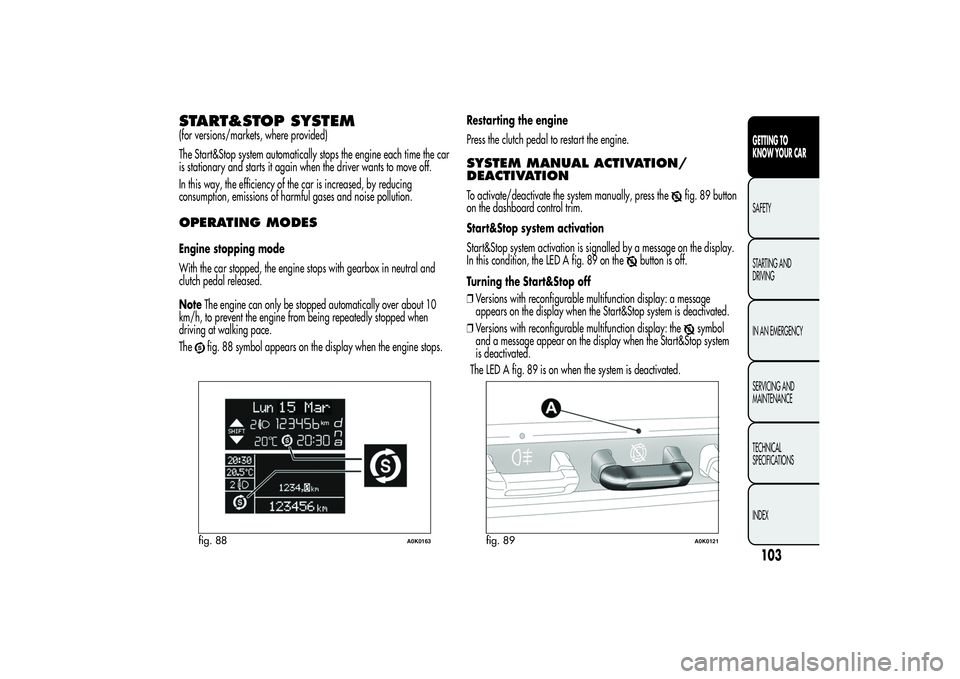
START&STOP SYSTEM(for versions/markets, where provided)
The Start&Stop system automatically stops the engine each time the car
is stationary and starts it again when the driver wants to move off.
In this way, the efficiency of the car is increased, by reducing
consumption, emissions of harmful gases and noise pollution.OPERATING MODESEngine stopping mode
With the car stopped, the engine stops with gearbox in neutral and
clutch pedal released.
NoteThe engine can only be stopped automatically over about 10
km/h, to prevent the engine from being repeatedly stopped when
driving at walking pace.
The
fig. 88 symbol appears on the display when the engine stops.Restarting the engine
Press the clutch pedal to restart the engine.
SYSTEM MANUAL ACTIVATION/
DEACTIVATIONTo activate/deactivate the system manually, press the
fig. 89 button
on the dashboard control trim.
Start&Stop system activation
Start&Stop system activation is signalled by a message on the display.
In this condition, the LED A fig. 89 on the
button is off.
Turning the Start&Stop off
❒Versions with reconfigurable multifunction display: a message
appears on the display when the Start&Stop system is deactivated.
❒Versions with reconfigurable multifunction display: the
symbol
and a message appear on the display when the Start&Stop system
is deactivated.
fig. 88
A0K0163
fig. 89
A0K0121
103GETTING TO
KNOW YOUR CARSAFETY
STARTING AND
DRIVING
IN AN EMERGENCY
SERVICING AND
MAINTENANCE
TECHNICAL
SPECIFICATIONS
INDEX
The LED A fig. 89 is on when the system is deactivated.
Page 111 of 292

DUAL PINION ACTIVE STEERINGThis only operates with the key turned to MAR and the engine started.
The steering allows the force required at the steering wheel to be
adjusted to suit driving conditions. The different power assistance
modes can be selected via the d,n,a positions of the “Alfa DNA
System” lever (see paragraph entitled “Alfa DNA System”).
IMPORTANT After the battery is disconnected, the steering must be
initialised. The warning light switches on to indicate this. To carry out
this procedure, simply turn the steering wheel all the way from one end
to the other or drive in a straight line for about a hundred metres.
It is absolutely forbidden to carry out any after-market
operation involving steering system or steering column
modifications (e.g.: installation of anti-theft device)
that could badly affect performance and safety, invalidate the
warranty and also result in non-compliance of the car with
type-approval requirements.
WIRING FOR RADIO SYSTEM(for versions/markets, where provided)
If no car radio was requested at the time of purchase, the car is
provided with a compartment fig. 93 on the dashboard.
The radio setup system is composed of:
❒car radio power supply cables, front and rear speakers and an
aerial;
❒radio housing;
❒aerial on car roof.
The car radio must be fitted in the special compartment A fig. 93,
which can be accessed by pressing the two retaining tabs B in the
compartment itself; power supply cables are located in this area.
When connecting a car radio to the radio wiring
contact Alfa Romeo Authorized Services to prevent any
faults from occurring that might compromise the safety
of the car.
fig. 93
A0K0134
107GETTING TO
KNOW YOUR CARSAFETY
STARTING AND
DRIVING
IN AN EMERGENCY
SERVICING AND
MAINTENANCE
TECHNICAL
SPECIFICATIONS
INDEX
Page 125 of 292
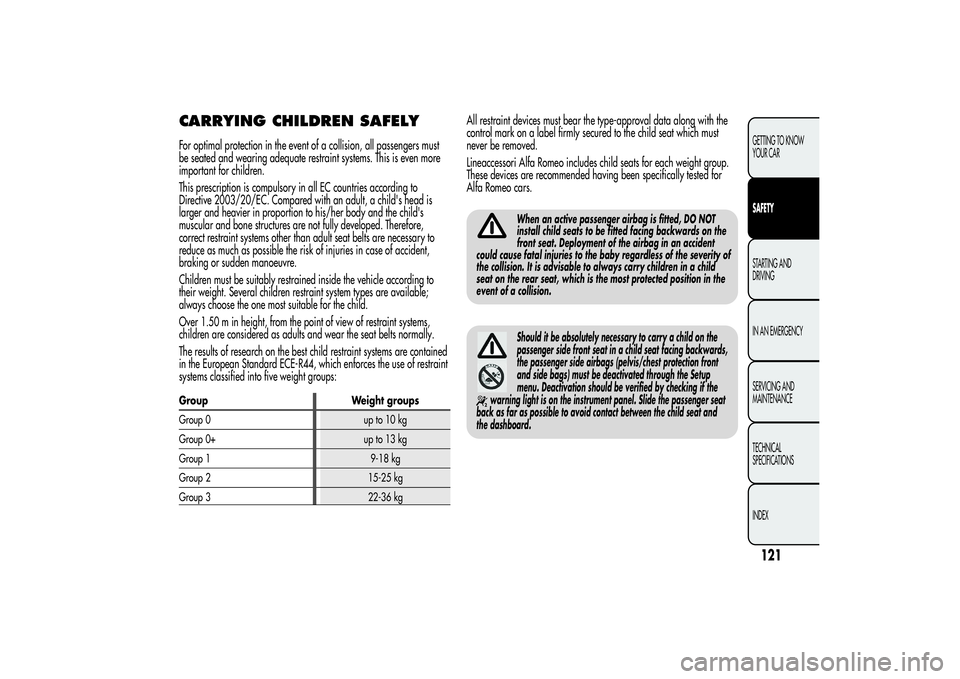
CARRYING CHILDREN SAFELYFor optimal protection in the event of a collision, all passengers must
be seated and wearing adequate restraint systems. This is even more
important for children.
This prescription is compulsory in all EC countries according to
Directive 2003/20/EC. Compared with an adult, a child's head is
larger and heavier in proportion to his/her body and the child's
muscular and bone structures are not fully developed. Therefore,
correct restraint systems other than adult seat belts are necessary to
reduce as much as possible the risk of injuries in case of accident,
braking or sudden manoeuvre.
Children must be suitably restrained inside the vehicle according to
their weight. Several children restraint system types are available;
always choose the one most suitable for the child.
Over 1.50 m in height, from the point of view of restraint systems,
children are considered as adults and wear the seat belts normally.
The results of research on the best child restraint systems are contained
in the European Standard ECE-R44, which enforces the use of restraint
systems classified into five weight groups:Group Weight groups
Group0 upto10kg
Group 0+ up to 13 kg
Group 1 9-18 kg
Group 2 15-25 kg
Group 3 22-36 kg
All restraint devices must bear the type-approval data along with the
control mark on a label firmly secured to the child seat which must
never be removed.
Lineaccessori Alfa Romeo includes child seats for each weight group.
These devices are recommended having been specifically tested for
Alfa Romeo cars.
When an active passenger airbag is fitted, DO NOT
install child seats to be fitted facing backwards on the
front seat. Deployment of the airbag in an accident
could cause fatal injuries to the baby regardless of the severity of
the collision. It is advisable to always carry children in a child
seat on the rear seat, which is the most protected position in the
event of a collision.Should it be absolutely necessary to carry a child on the
passenger side front seat in a child seat facing backwards,
the passenger side airbags (pelvis/chest protection front
and side bags) must be deactivated through the Setup
menu. Deactivation should be verified by checking if the
warning light is on the instrument panel. Slide the passenger seat
back as far as possible to avoid contact between the child seat and
the dashboard.
121GETTING TO KNOW
YOUR CARSAFETYSTARTING AND
DRIVING
IN AN EMERGENCY
SERVICING AND
MAINTENANCE
TECHNICAL
SPECIFICATIONS
INDEX
Page 133 of 292

FRONT AIRBAGSThe car features multistage front airbags (“Smart bags”) for driver and
passenger.“SMART BAG” SYSTEM
(MULTISTAGE FRONT AIRBAGS)The front (driver and passenger) airbags protect occupants in the event
of head-on crashes of medium-high severity, by placing the a cushion
between the occupant and the steering wheel or dashboard.
Therefore non-deployment in other types of impacts (side impacts, rear
shunts, roll-overs, etc.) does not indicate a system malfunction.
The airbags do not replace, but rather complement, the use of seat
belts, which should always be worn. In the event of an impact,
someone not wearing a seat belt could move forward and come into
contact with a bag which is still in the opening phase. The protection
offered by the bag is compromised in these circumstances.
Front airbags may not activate in the following situations:
❒frontal impacts against highly deformable objects not involving the
front surface of the car (e.g. wing collision against guard rail);
❒jamming of the car underneath other vehicles or protective barriers
(e.g. underneath a truck or a guard rail); in this case, the bags
would offer no additional protection with respect to the seat belt and
their deployment would be inappropriate. In these cases, non-
deployment does not indicate a system malfunction.
Do not apply stickers or other objects to the steering
wheel, to the passenger's side air bag cover or on the
roof side lining. Do not place objects on the passenger
side of the dashboard because these could interfere with the
correct opening of the passenger airbag and cause injury to
occupants.
FRONT DRIVER SIDE AIRBAGThis is located in a dedicated compartment in the centre of the steering
wheel fig. 114.
Always drive with your hands on the steering wheel
rim so that the airbag can inflate freely if necessary.
Do not drive with your body bent forward. Keep the
back of your seat upright and lean back into it.
fig. 114
A0K0080
129GETTING TO KNOW
YOUR CARSAFETYSTARTING AND
DRIVING
IN AN EMERGENCY
SERVICING AND
MAINTENANCE
TECHNICAL
SPECIFICATIONS
INDEX
Page 134 of 292
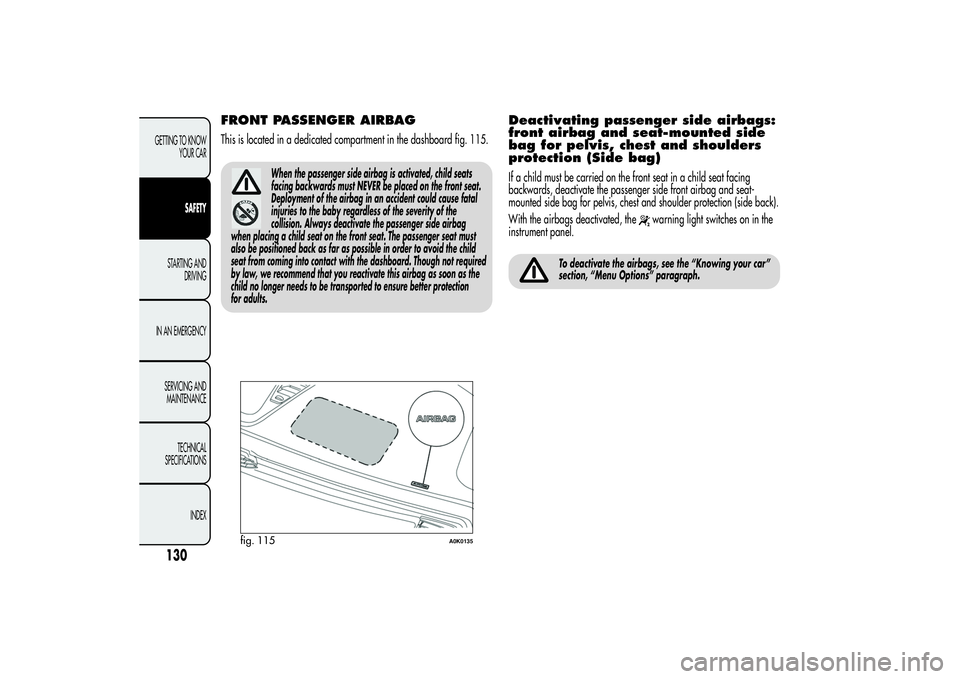
FRONT PASSENGER AIRBAGThis is located in a dedicated compartment in the dashboard fig. 115.
When the passenger side airbag is activated, child seats
facing backwards must NEVER be placed on the front seat.
Deployment of the airbag in an accident could cause fatal
injuries to the baby regardless of the severity of the
collision. Always deactivate the passenger side airbag
when placing a child seat on the front seat. The passenger seat must
also be positioned back as far as possible in order to avoid the child
seat from coming into contact with the dashboard. Though not required
by law, we recommend that you reactivate this airbag as soon as the
child no longer needs to be transported to ensure better protection
for adults.
Deactivating passenger side airbags:
front airbag and seat-mounted side
bag for pelvis, chest and shoulders
protection (Side bag)If a child must be carried on the front seat in a child seat facing
backwards, deactivate the passenger side front airbag and seat-
mounted side bag for pelvis, chest and shoulder protection (side back).
With the airbags deactivated, the
warning light switches on in the
instrument panel.
To deactivate the airbags, see the “Knowing your car”
section, “Menu Options” paragraph.
fig. 115
A0K0135
130GETTING TO KNOW
YOUR CAR
SAFETY
STARTING AND
DRIVING
IN AN EMERGENCY
SERVICING AND
MAINTENANCE
TECHNICAL
SPECIFICATIONS
INDEX
Page 153 of 292

"Fix&Go Automatic" kitThis is located in the luggage compartment (the kit container may vary
according to version - see fig. 131).
The kit container also contains a screwdriver and the tow hook.The kit also contains:
❒a bottle fig. 132 containing sealer and fitted with: filling tube B and
adhesive label C with the wording “max. 80 km/h” to be placed in
a clearly visible position (e.g. on the dashboard) after repairing
the tyre;
❒a compressor D complete with pressure gauge and connectors;
❒an information leaflet fig. 133, providing instructions for using the
kit correctly. This booklet should be given to the persons charged
with handling the tyre treated with this kit;
❒a pair of gloves located in the side compartment of the compressor;
❒adapters for inflating different elements.
IMPORTANT The sealing liquid is suitable for use at temperatures in the
range from –20°C to +50°C. The sealant has an expiry date.
Give the leaflet to the technicians who will be handling
the tyre that was treated using the "Fix&Go Automatic"
kit.
fig. 131
A0K0126
fig. 132
A0K0019
149GETTING TO KNOW
YOUR CAR
SAFETY
STARTING AND
DRIVINGIN AN
EMERGENCYSERVICING AND
MAINTENANCE
TECHNICAL
SPECIFICATIONS
INDEX
Page 170 of 292
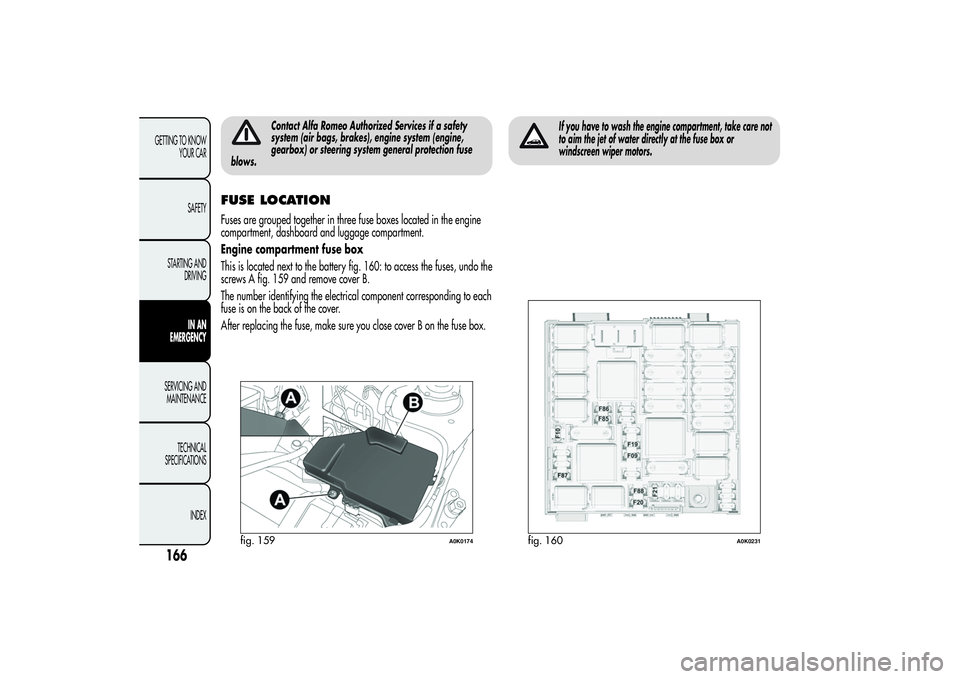
Contact Alfa Romeo Authorized Services if a safety
system (air bags, brakes), engine system (engine,
gearbox) or steering system general protection fuse
blows.
FUSE LOCATIONFuses are grouped together in three fuse boxes located in the engine
compartment, dashboard and luggage compartment.
Engine compartment fuse box
This is located next to the battery fig. 160: to access the fuses, undo the
screws A fig. 159 and remove cover B.
The number identifying the electrical component corresponding to each
fuse is on the back of the cover.
After replacing the fuse, make sure you close cover B on the fuse box.
If you have to wash the engine compartment, take care not
to aim the jet of water directly at the fuse box or
windscreen wiper motors.
fig. 159
A0K0174
fig. 160
A0K0231
166GETTING TO KNOW
YOUR CAR
SAFETY
STARTING AND
DRIVING
IN AN
EMERGENCY
SERVICING AND
MAINTENANCE
TECHNICAL
SPECIFICATIONS
INDEX
Page 171 of 292

Dashboard fuse box
Insert a hand in housing A fig. 162 and lower flap B to access the
fuses fig. 161.
fig. 161
A0K0206
fig. 162
A0K0244
167GETTING TO KNOW
YOUR CAR
SAFETY
STARTING AND
DRIVINGIN AN
EMERGENCYSERVICING AND
MAINTENANCE
TECHNICAL
SPECIFICATIONS
INDEX
Page 237 of 292
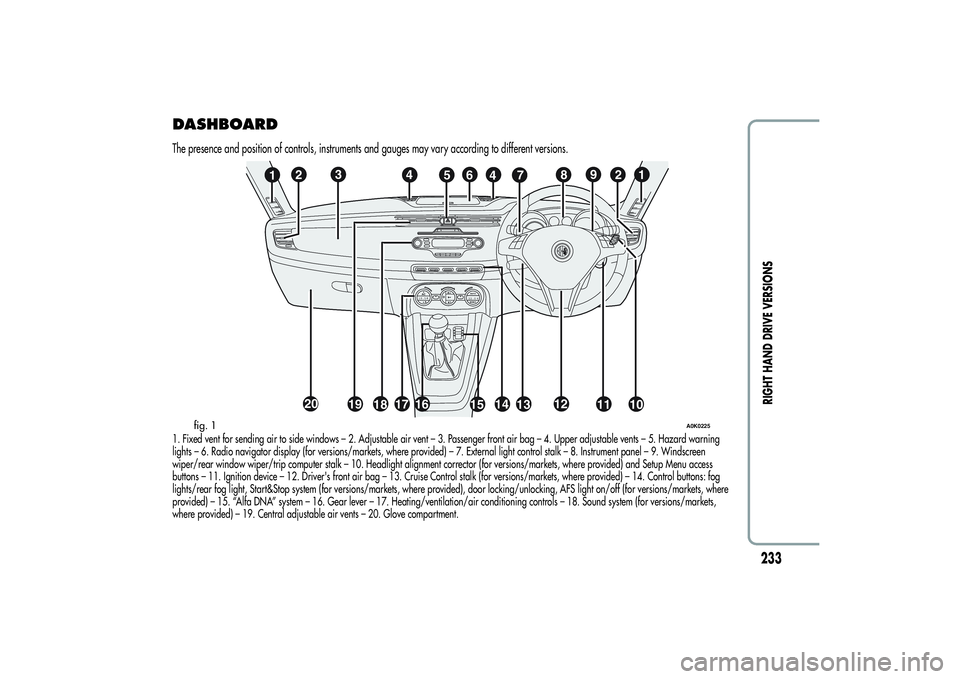
DASHBOARDThe presence and position of controls, instruments and gauges may vary according to different versions.1. Fixed vent for sending air to side windows – 2. Adjustable air vent – 3. Passenger front air bag – 4. Upper adjustable vents – 5. Hazard warning
lights – 6. Radio navigator display (for versions/markets, where provided) – 7. External light control stalk – 8. Instrument panel – 9. Windscreen
wiper/rear window wiper/trip computer stalk – 10. Headlight alignment corrector (for versions/markets, where provided) and Setup Menu access
buttons – 11. Ignition device – 12. Driver's front air bag – 13. Cruise Control stalk (for versions/markets, where provided) – 14. Control buttons: fog
lights/rear fog light, Start&Stop system (for versions/markets, where provided), door locking/unlocking, AFS light on/off (for versions/markets, where
provided) – 15. “Alfa DNA” system – 16. Gear lever – 17. Heating/ventilation/air conditioning controls – 18. Sound system (for versions/markets,
where provided) – 19. Central adjustable air vents – 20. Glove compartment.
19.5
22.0
cACA
AUTO
MONOC
123
4
56
4789
21
20
19
1817
16
1514
1312
1110
fig. 1
A0K0225
233
RIGHT HAND DRIVE VERSIONS
Page 240 of 292

CHANGING A FUSEFUSEBOX ON DASHBOARDInsert a hand in the seat A fig. 4 and lower the flap B to access the
fuses.
The fuses are located in the fusebox shown in fig. 5.Note
For fuse protected devices refer to the description of “In an emergency”
chapter.
fig. 4
A0K0246
fig. 5
A0K0249
236
RIGHT HAND DRIVE VERSIONS